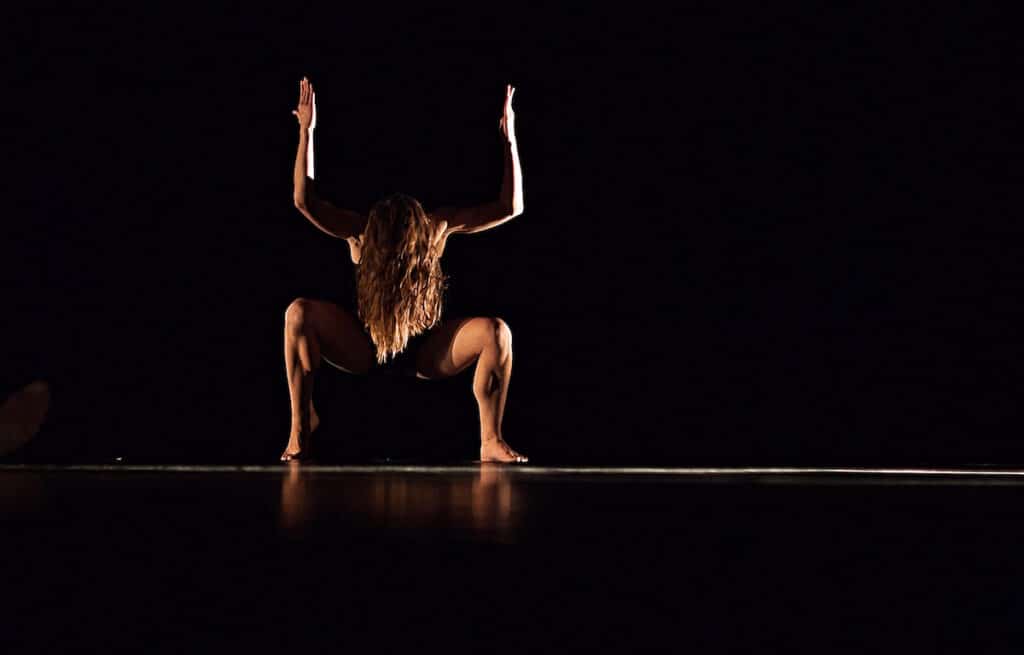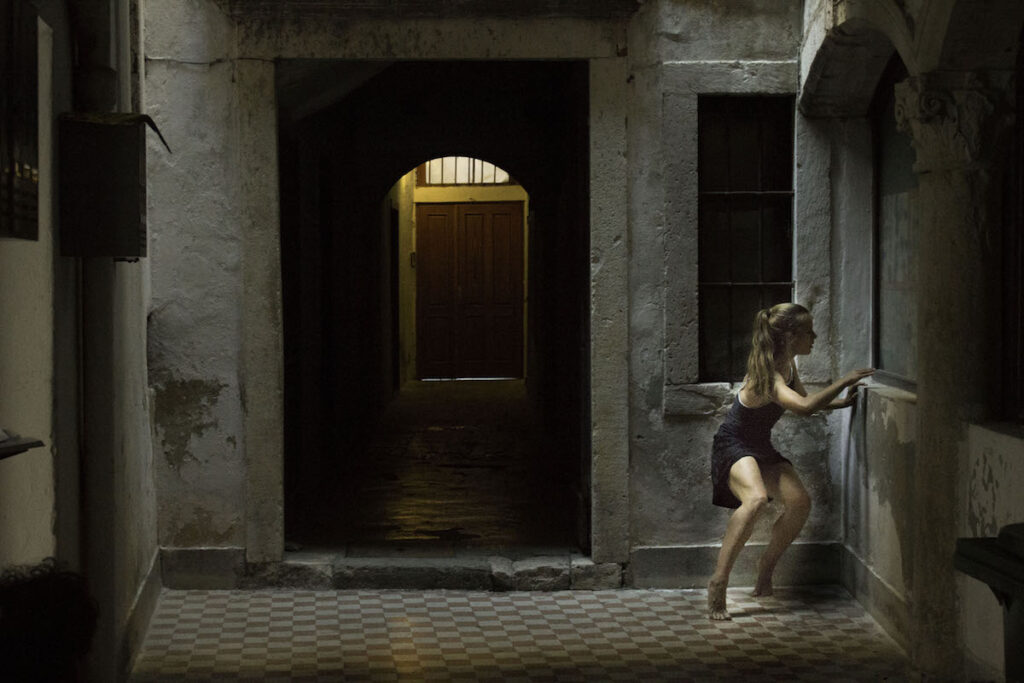“I think, that people can learn empathy through dance”, dancer Lucija Mikas said. She began her dance career at the age of eleven at the John Cranko School in Stuttgart and quit her classic ballet education there, after four years of hard training. What she learned during this strict dance lessons, confirms established clichés as she says “Discipline is definitely necessary, because classic ballet is on the same level with ice skating and gymnastics. To perform great accomplishments, unbelievable discipline and forces are required. Looking back, I don’t regret going to that school, because I captured a kind of discipline I can use for other areas.” Even if Mikas is very grateful for this experience, she realized, that this path was not her destiny. She turned towards contemporary dance, also because in that area talent is understood in a slightly different way. “There, talent is measured with creativity, expression or improvisation. […] Contemporary dance is described a physical expression of ideas and emotions.” So she decided to complete her degree at the Academy for Contemporary Dance in Berlin. She worked within several projects until she decided to move to Croatia, where she fell in love and has lived there ever since. A very limited cultural range and the lack of infrastructure in her professional world forced her to improve her skills and to organize her own projects. “That’s how how I started to teach myself how to write projects, which still benefits me greatly. I created an infrastructure, which on the one hand is an advantage for the teenagers and their projects and on the other hand generates an infrastructure for people who live out of town. Thats how we can apply for resources together, so that we are able to work on a professional level. After all those years, I can now say, that I created a network I can work with. For four years I now teach at a school as a dance teacher where I train contemporary dance.” What she learned at a very young age through her strict dance lessons, is to have discipline and to challenge herself. We asked her, how much talent dancers have to bring with them and how much they have to revise with discipline.

The Process
As diverse the disciplines of Lucija Mikas are, as universally usable is the artistic creation for her. “I don’t want to confine the process to the artistic because it cuts across all areas of life. At the beginning I have an idea or an incident. It can also be a unreflected experience out of the past, that I now confront myself with. After that I check what I already have for the transformation and what’s missing. Then I ponder the potential of the idea, split it into segments, which I pursue and get closure. The closure then is the implementation.”
The Idea
“First, every movement emerges as a reaction of the emotional life. Contemporary dance is seen as a physical expression of ideas and emotions,” explains Lucija Mikas during the conversation about the origin of her ideas. “I for example see a fig tree, growing out of a stone. This fig tree reminds me of my rootlessness, because I don’t see his roots. The tree seems loose and not graspable. Other than an olive tree in the garden, where one exactly knows and sees, that he belongs to this garden. Then I put myself in the trees position and can pursue various approaches. I can start with the texture of the tree and feel how the leaves are constituted or how the roots are running. The metaphor can be followed and it can be seen that the tree only has small roots and doesn’t belong there. That I can translate into my life and on my art. Out of this inner feeling I can create movement while I physically transform, what structure the tree possesses. Due to improvisation a certain movement arises as a reaction. Either I define this movement or I let it loose. I can declare the freedom of the structure of a piece, so that it is being completely improvised or that it follows a determined structure with constituted movements.”

The Creation
Even if the result of Mikas’ work is defined by structured procedures, the path to get there is characterized by the act in the moment, by playful improvisation and she isolates this procedure from focus and success orientation. “Due to my sensibility, concentration is a word, that doesn’t harmonize with improvisation. For me concentration has something to do with focus to do something willingly, which emerges out of a thought of success. Improvisation is better described by letting go. Even if one is concentrated, one stays open for influences. Maybe it’s a paradox and is similar to meditation, someone wants to do and absolutely wants to achieve. Most often, the fault is, that one is too restricted on the delivery and tries to absolve those things step by step. Basically, improvisation appears always and in every step, but if you emanate from a classical process then above all, at the beginning. Of course improvisation can be found on stage. I enjoy provoking something in a person and especially the surprise effect, that in every person you trigger something else. On the one hand, I think, that everyone on stage is desires applause. On the other hand nearly all artists state, that they feel the urge to do their art out of themselves. And I’m not an exception, but most important for me is the process, because I experience it as liberating.” A release, that also grows out of the collaboration with other people. For example the contact with other artists, the testing and experiencing of movement and the influence of another body for the own physical feeling. ”Dance has to do a lot with empathy. Contact with the outside world is being absorbed by the scences. Through a touch, the opponent can be experienced at once. Often much more direct than through eye contact, acoustic or scent, because the information is being sensed with the whole body. If I touch something hot, I feel it immediately. After collecting experiences and the analysis of a topic there is the synthesis. Little by little I put together individual fragments and finalize details. Thereby it’s helpful if someone from the outside has a look upon your work. In my case, that can be a director, an acquaintance or a colleague, who gives me feedback.” Furthermore she talks about the necessity of constructive critique to be aware of oneself in a new light and to evolve. “Doing ballet, I also learned to be grateful for constructive critique, because it is extremely important. In my opinion, other dancers are too sensitive and take critique personally too fast. with those people it’s also hard to work with. I adduce my pupils very fast, to be open minded and objective with their feedback. At the same time, it’s very important to be righteous and fair and to be mindful of not attacking someone personally.” If all of that works out, one day there is the performance in front of an audience. Thereby, Mikas clearly refuses the concept of perfection when she says, “It’s never really done. The need of the performance is a goal you work toward, for that moment your work is done, but can be completely different in a month. Today, we have every opportunity in forms of video and recordings, so that we can file everything, but dance is not determined for eternity. That’s as well reflected in the philosophy and way of live of dance, that you live from one moment into the other. Only if you live in the moment, you can really live the dance. It’s the art of the moment. […] There is no security. Terms like fault or failure only exist if you allow them. I experience failure when you don’t remain true to yourself and if you agree to a compromise that you’re barely willing to make.”
The full interview with Lucija Mikas in German language
Info
Text by Adina Asbeck.
Edited by Stephanie Barnes.
The interview was conducted by Dirk Dobiéy on 14/08/2015.
Image source: Florian Hammerich, Srđan Babić.
